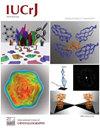Accounting for electron-beam-induced warping of molecular nanocrystals in MicroED structure determination
IF 3.6
2区 材料科学
Q2 CHEMISTRY, MULTIDISCIPLINARY
引用次数: 0
Abstract
Here we identify and characterize the warping of molecular crystal lattices induced by electron beam exposure during microcrystal electron diffraction (MicroED/3DED) data collection. We find changes to consensus crystal lattice orientation that are often dramatic, and appear ubiquitous in small organic molecule crystals. This evidence highlights the relevance of crystal bending or warping as a consequence of radiation-induced damage on molecular specimens, and points to it as a fundamental source of error in MicroED/3DED data collection and structure determination.
High-energy electrons induce sample damage and motion at the nanoscale to fundamentally limit the determination of molecular structures by electron diffraction. Using a fast event-based electron counting (EBEC) detector, we characterize beam-induced, dynamic, molecular crystal lattice reorientations (BIRs). These changes are sufficiently large to bring reciprocal lattice points entirely in or out of intersection with the sphere of reflection, occur as early events in the decay of diffracted signal due to radiolytic damage, and coincide with beam-induced migrations of crystal bend contours within the same fluence regime and at the same illuminated location on a crystal. These effects are observed in crystals of biotin, a series of amino acid metal chelates, and a six-residue peptide, suggesting that incident electrons inevitably warp molecular lattices. The precise orientation changes experienced by a given microcrystal are unpredictable but are measurable by indexing individual diffraction patterns during beam-induced decay. Reorientations can often tilt a crystal lattice several degrees away from its initial position before irradiation, and for an especially beam-sensitive Zn(II)-methionine chelate, are associated with dramatic crystal quakes prior to 1 e− Å−2 electron beam fluence accumulates. Since BIR coincides with the early stages of beam-induced damage, it echoes the beam-induced motion observed in single-particle cryoEM. As with motion correction for cryoEM imaging experiments, accounting for BIR-induced errors during data processing could improve the accuracy of MicroED data.
电子束致分子纳米晶体翘曲在微电子显微镜结构测定中的应用。
高能电子在纳米尺度上诱导样品损伤和运动,从根本上限制了电子衍射对分子结构的测定。使用快速事件电子计数(EBEC)探测器,我们表征了光束诱导的动态分子晶格重定向(BIRs)。这些变化足够大,足以使倒易晶格点完全与反射球相交或不相交,发生在由于辐射分解损伤引起的衍射信号衰减的早期事件中,并且在相同的影响范围内,在晶体上的相同照射位置,与光束诱导的晶体弯曲轮廓迁移相吻合。这些效应在生物素、一系列氨基酸金属螯合物和六残基肽的晶体中观察到,表明入射电子不可避免地会扭曲分子晶格。一个给定的微晶体所经历的精确取向变化是不可预测的,但可以通过在光束诱导衰减期间索引单个衍射模式来测量。重定向通常可以使晶格从辐照前的初始位置倾斜几度,对于特别对电子束敏感的锌(II)-蛋氨酸螯合物,在1 e- Å-2电子束影响积累之前,与剧烈的晶体震动有关。由于BIR与束致损伤的早期阶段相吻合,因此它与单粒子低温电镜中观察到的束致运动相呼应。与低温成像实验的运动校正一样,在数据处理过程中考虑birr引起的误差可以提高MicroED数据的准确性。
本文章由计算机程序翻译,如有差异,请以英文原文为准。
求助全文
约1分钟内获得全文
求助全文
来源期刊

IUCrJ
CHEMISTRY, MULTIDISCIPLINARYCRYSTALLOGRAPH-CRYSTALLOGRAPHY
CiteScore
7.50
自引率
5.10%
发文量
95
审稿时长
10 weeks
期刊介绍:
IUCrJ is a new fully open-access peer-reviewed journal from the International Union of Crystallography (IUCr).
The journal will publish high-profile articles on all aspects of the sciences and technologies supported by the IUCr via its commissions, including emerging fields where structural results underpin the science reported in the article. Our aim is to make IUCrJ the natural home for high-quality structural science results. Chemists, biologists, physicists and material scientists will be actively encouraged to report their structural studies in IUCrJ.
 求助内容:
求助内容: 应助结果提醒方式:
应助结果提醒方式:


